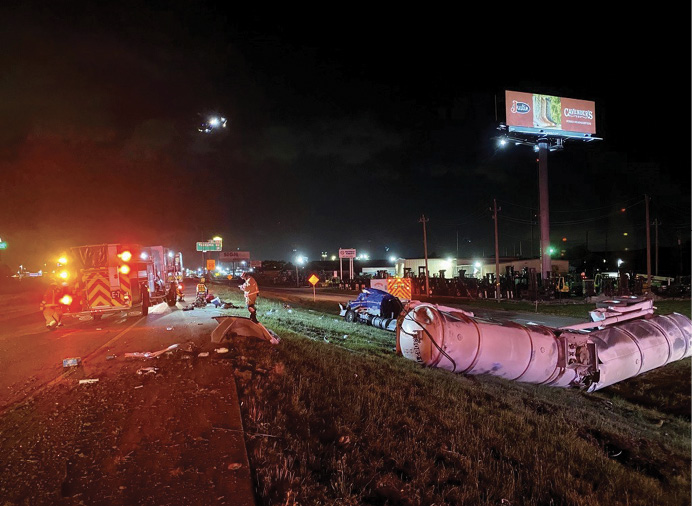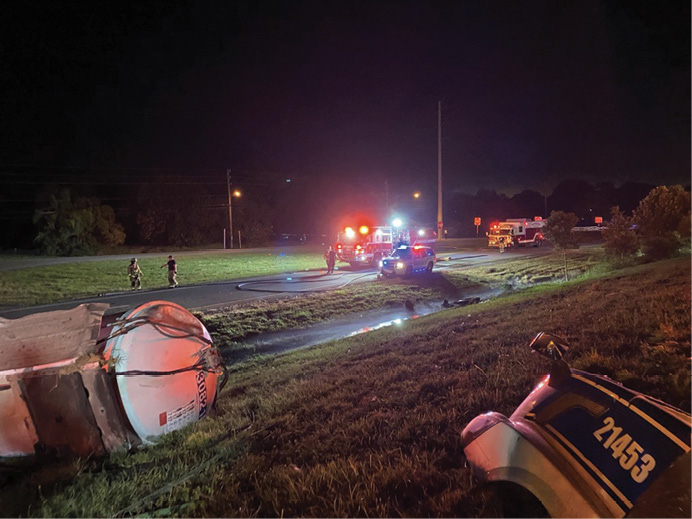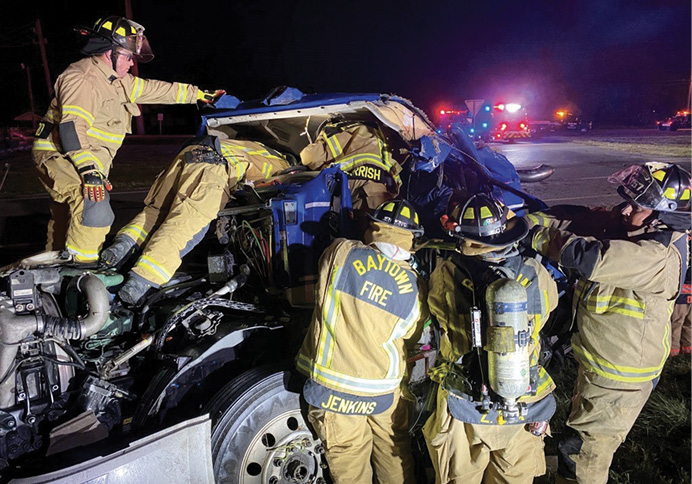By Patrick S. Mahoney
In June 2020, a tractor trailer rig traveling westbound on Interstate 10 in Baytown, Texas, left the road at highway speed and rolled over. The tank trailer, an MC 307/DOT 407 type, was carrying 7,560 gallons of natural gasoline from a nearby loading terminal. The tractor and trailer separated; the tractor came to rest upright but was severely damaged. The trailer came to rest on its side, spanning a ditch, and broke in half. The driver was heavily entrapped in the cab, conscious but severely injured. The Baytown Fire Department (BFD) responded to find a complicated and dangerous situation that taught lessons in risk management, situational awareness, crew resource management, and communications (photo 1).
The BFD is a municipal career fire department with seven engines, a tower truck, and five MICU ambulances. The department’s authorized strength is approximately 164 uniformed members. All members are certified by the State of Texas as professional firefighters with a minimum of hazmat operations training and emergency medical technician-basic certification. Many members are also hazardous materials technicians and paramedics.
Since 2003, the department has operated a regional hazmat/weapons of mass destruction team through the Urban Area Security Initiative. The team covers the east side of the Houston-Galveston metropolitan area, roughly between the Houston Ship Channel and the Trinity River. This area encompasses a worldwide logistics hub; some of the largest refineries and petrochemical facilities in the Western Hemisphere; and concentrations of hazardous truck, barge, and rail traffic seen in few other parts of the country.
RELATED FIREFIGHTER TRAINING
- Rollover Extrication: Upside Down with Nowhere to Go
- Photos: Lyons (IL) Tanker Rollover
- LPG TANKER ROLLOVER: LESSONS LEARNED IN SUFFOLK, VIRGINIA
This incident occurred just after midnight along a busy interstate. A low-density residential neighborhood was approximately 300 feet north-northeast from where the trailer came to rest. Light industry approximately 500 feet west of the scene was, fortunately, closed for the night. Generally, the Houston region features flat coastal topography. Whereas topography is a size-up concern in most of the country, it rarely is in this area. In this instance, the freeway is at a higher elevation than the I-10 Frontage Road that runs parallel on both sides but is approximately 20 to 30 feet lower. Weather at the time was 78°F with 93% relative humidity and southeast winds at three miles an hour.
Natural gasoline is a flammable condensate from petroleum wells similar to commercial gasoline but of a lower octane. It is used in various blends to produce commercial gasoline and ethanol-blended fuel. Both the Emergency Response Guidebook (ERG) and Wireless Information System for Emergency Responders (WISER) include natural gasoline in their protective actions and distances for commercial-grade gasoline. Specifically, the isolation distance for large spills is 50 meters in all directions and the evacuation distance is 300 meters downwind.1 Natural gasoline has a vapor density of 3.0 to 4.0, a flashpoint of –50°F, and an explosive range of 1.4% to 7.8%.2
Initial Dispatch
The initial dispatch consisted of two engines (each staffed with a lieutenant, an equipment operator, and two firefighters), a tower ladder (a lieutenant and an equipment operator), a medic unit (two firefighters), a command vehicle (a battalion chief with a lieutenant as aide), and an emergency medical services (EMS) supervisor (a lieutenant). The first report indicated a tanker on fire with victims trapped. The battalion chief requested three more engines en route because of the apparent scale of the incident and anticipated water supply needs.

(1) To the right of the I-10 pavement, the tank trailer lies across a ditch, broken and empty. The driver remains trapped in the tractor cab. (Photos by author.)
A complication immediately arose. The first-due engine company was Engine 7 (E7). E7 is one of the BFD’s two heavy extrication companies; it is also the bulk of the on-duty hazmat team. Two hazmat apparatus are housed at Station 7 along with E7 and Tower 7 (T7). The crew from the engine cross-staffs the hazmat apparatus. Had the incident occurred in another part of the city, the problem would have been mitigated; in this case the first-due fire company was also the extrication company and the staffing for the hazmat apparatus.
All agencies confront staffing problems eventually. Fire officers must remember that staffing is similar to water application—the key is usually the application rate, not the total quantity. This incident required several discrete activities immediately; officers had to make tough calls about which to perform and which to put off until later.
En route, the battalion chief radioed the T7 crew to bring the hazmat apparatus instead of the tower truck. They are also part of the hazmat team but are not normally expected to cross-staff the apparatus. At the time, the tower was only staffed with two members; it is unusual in this agency for a single member to drive a heavy apparatus. They therefore brought Hazmat 7 (HM7), the primary hazmat truck, and left the hazmat utility truck and trailer. This would shortly present another problem.
Arrival and Size-Up
E7 arrived first with the lieutenant, reporting no fire but an unknown type of hazmat spill and an entrapment. He assigned his crew and that of Medic 7 (M7) to patient care and extrication. The lieutenant then conducted a 360° survey and hazmat reconnaissance of the scene to characterize the problem. At about this time, an engine from a neighboring volunteer fire department arrived on scene, having been dispatched because of a misrouted cell phone 911 call. Two of their members donned bunker gear and assisted the E7 and M7 crews with extrication. The battalion chief soon arrived and assumed command. Additional engine companies arrived and covered critical tasks.
An officer’s first task is risk assessment and management. We will risk a lot to save a lot and risk little to save little, but what does this mean on the street? Sometimes we can only say we know it when we see it. Here, firefighters confronted a trapped but viable victim and a very large flammable spill with uncontrolled ignition sources in the area. Firefighters do not often have the luxury of waiting for a scene to become safe. In this case, members had to go to work with the freeway still open, albeit at a crawl. A crowd of tow truck drivers and law enforcement personnel was forming and cars continued to pass by. The incident commander (IC) instructed all these nonfire bystanders to leave the area immediately and the police to close the freeway. The BFD has a strong working relationship with the Baytown Police Department; they worked quickly to clear the area and close the highway. One early-arriving police officer parked his patrol vehicle immediately adjacent to the spill and had to abandon it in place when evacuating (photo 2).
Hydraulic extrication on a heavy-duty truck can be difficult because of the heavier construction. Removing the patient is more difficult because of the height of the cab. Members here were forced to work standing on the engine block, on a saddle tank, and after crawling through the reduced clearance of the crushed windshield. Because of the hazards on scene, this patient was a candidate for an emergency extrication in which no C-spine precautions or treatment is provided; the patient is simply pulled out of the vehicle. Unfortunately, the patient was actually pinned and this was not an option. E7 and M7 set up hydraulic rams, spreaders, and cutters, using a gasoline power unit, and went to work. The volunteers from the neighboring department assisted but had to leave to respond to a high-acuity medical call in their own jurisdiction. The loss of personnel during intense operations was unexpected and inconvenient but understandable (photo 3).
The IC had E7 pull a handline off tank water for cover. There was no hydrant within 1,000 feet or the length of one engine’s load of supply line. Engine 5 (E5) arrived next and caught a hydrant north of the frontage road but could not join E7 because of the intervening grassy median. Command felt E7’s handline and tank water would be adequate as a contingency measure; if the spill ignited, there would be enough water long enough to allow working crews to back out.

(2) Crews operating on the service road on the low side of the incident encounter a vapor cloud blanketing the area. What was initially thought to be standing water turned out to be gasoline.
Despite the E7 lieutenant’s reconnaissance of the scene, it was still not clear what the product on the ground was. All members present reported the smell of mercaptan. The entrapped driver reported that she was carrying “natural gas.” The shipping papers could not be immediately located. The tank trailer was clearly not a pressure vessel and was placarded as 1203, the placard normally carried by gasoline shipments. The lieutenant and the IC discussed this mismatch between the ambient smell, the driver’s report, and the trailer. Neither had ever heard of a product called natural gasoline.
Little noticed at the time was the liquid in the ditch the trailer was lying across. This area is near Galveston Bay, and standing water is common. Firefighters gather data (raw information) to produce intelligence on which to base decisions. How do you derive intelligence from contradictory data?
Briefly, the lieutenant and battalion chief considered that this was some rare form of nonliquefied natural gas transport that perhaps did not require a traditional pressure vessel and was just unknown to them. This would fit the driver’s report and the ambient smell but contradict the placards and prior experience and knowledge of the container type.
Decisions in the moment had to be made about the worst case possible, which was that members were operating in a persisting flammable atmosphere, while more data was gathered. Here, the rare topography issue first came into play. The ditch was some 20 to 30 feet lower than the freeway, where command and E7 were located. The product carried has vapors three to four times heavier than air. E7’s lieutenant went into the ditch to examine the trailer more closely and it was immediately obvious that the liquid was gasoline, not water. The mercaptan smell was transient, apparently from one of the many industrial facilities in the area, spurious data present in the wrong place at the wrong time.
Knowing that the product was gasoline and that it was on the ground in a large pool adjacent to and among working firefighters was clarifying but not comforting. HM7 arrived on the scene on the frontage road near E5. The pond separated E5 and HM7 from E7, M7, and the IC. Although they could see each other, they could not safely traverse the gap.
Command ordered HM7 to establish a foam operation. After some delay, it was determined this could not be done. No foam was present on HM7; the team had moved all of it to the utility truck and trailer that had been left at the station. This was normally immaterial as the two units respond together, but cross-staffing apparatus will inevitably lead to problems like this on occasion. A later-arriving engine was directed to respond to Station 7 to retrieve the hazmat utility truck and trailer.
Within approximately 15 minutes of the BFD’s arrival on scene, the patient was extricated, transferred to an ambulance, and removed to a landing zone for aeromedical transport. ICs should habitually reevaluate their risk profile as they pass strategic benchmarks. Although we are accustomed to thinking of this in terms of structure fires, it can be just as true at any other kind of incident.
In this case, the IC succumbed to inertia and did not recognize that a lower level of risk acceptance was indicated. Operations thus continued with no permanent water supply, no foam, and a geographically dispersed workforce. The thinking was that crews had been in this environment and it had not ignited, so it must be safe. A police vehicle had even parked within feet of the gasoline without igniting it, serving as a very visible and reliable air monitor. This is flawed thinking. We must be careful not to confuse being lucky with being good. In hazmat, we should recognize that an atmosphere that is too rich at any given time is more dangerous than an atmosphere that is too lean.
Crews came to think of the incident in terms of high side (the freeway) and low side (the frontage road). These two areas were approximately 25 vertical feet apart and horizontally separated by perhaps 150 feet of grass and the pond of gasoline. Command failed also to account for the differences this topography would produce. Not until crews from E5 and HM7 reported that they were becoming lightheaded and requested permission to back out did command fully appreciate that there were, in effect, two different scenes and one was not tenable.
As the crews on the low side backed out to cleaner air and HM7 set up area air monitoring, subsequent engines and the hazmat utility apparatus arrived on the freeway. A warm zone was designated on the high side of the incident, where members could operate free from heavy vapor concentrations.

(3) Crew members work to extricate the entrapped driver, which they accomplished 15 minutes after arrival.
A straightforward foam operation was established. E7 applied aqueous film forming foam from the freeway with a low-expansion nozzle. Each engine on scene was equipped with a 750-gallon booster tank. Later-arriving units established a tank shuttle to supply the foam operation. Though this would not meet the reliability standard for water supply if people were still in the hot zone, by this time, everyone was able to operate from the warm zone. The operation concluded when vapors were suppressed and a remediation contractor arrived to begin cleanup.
Lessons Learned
Afterward, members felt this incident illustrated many points often discussed but rarely experienced. A frank after-action review identified the following lessons learned, and we hope they can be of use to the fire service at large.
- Before you go to work, consider what it means to “risk a lot to save a lot.” Consider it again each time you think about promoting. Just repeating this phrase as a mantra obscures the very serious mental and spiritual calculus behind it. To be blunt, when lives are in peril, we must understand and accept what is worth dying for and what is not worth dying for.
- Guard against assumptions about what you are sensing. Sort data, correlate it, and confirm it before you act on it. Until then, operate with a worst-case scenario in mind. The smell of mercaptan and the report from the driver that the cargo was “natural gas” seemed to confirm the hazmat’s identity but were at odds with everything else observed.
- Precision in communication is essential. The truck driver probably regularly referred to natural gasoline as “natural gas.” That sort of verbal shorthand is common for workers in any field. The fire service and especially hazmat responders must avoid colloquial terminology to prevent ambiguity when it counts.
- Officers absolutely must reevaluate risk acceptance as benchmarks are achieved. Do not let inertia carry you to a bad outcome.
- ICs should recognize that topography and response routes at hazmat incidents can place crews in very different environments. Do not assume that everyone is as physically secure and comfortable as you are.
- Do not assume everyone is mentally operating at the same scene. The purpose of incident communication is to establish a common operating picture that is shared by all workers. When there is no effective common operating picture, you may encounter disparate levels of risk and urgency among working crews. At this scene, the drastically different activities and environments on the high side and low side caused crews in the two positions to experience different effects and misunderstand the priorities of the other.
- Effective response is often about rate of application of personnel. Call for additional resources early to get what you need when you need it. The objective of a response plan is to accomplish critical tasks in parallel rather than in series.
- Each engine company should carry a minimum requirement of foam. Depending on one specialized apparatus for the bulk of foam works well, but initiating a foam operation should not depend on that apparatus being present on scene.
- Be mentally flexible about response and recognize the limitations of cross-staffing specialty apparatus.10. Heavy duty trucks present a unique extrication challenge. Train and plan for these low-frequency operations.11. Personal protective equipment (PPE) is cumbersome and uncomfortable during Gulf Coast summers. Officers must strictly enforce PPE mandates but must also be realistic about physical limits of endurance.
12. Fire-based EMS allows provision of advanced medical care in hazard zones. In the BFD, all the firefighters are EMTs or paramedics; all but the most senior rotate shifts between the engines and ambulances. Hence, the ambulance crew on the day of the incident was comprised of both firefighters and, because they were from Station 7, hazmat team members. The all-hazards approach to nonlaw enforcement emergency response paid dividends at this incident.
13. Know before the incident where you can get more foam on short notice.
References
1. U.S. Department of Transportation. Emergency Response Guidebook. Washington, DC. https://www.phmsa.dot.gov/hazmat/erg/emergency-response-guidebook-erg.
2. U.S. National Library of Medicine. Wireless Information System for Emergency Responders. Bethesda, MD. https://wiser.nlm.nih.gov/.
Patrick S. Mahoney is a battalion chief and shift commander for the Baytown (TX) Fire Department. He joined the fire service in 1998 and has been a career firefighter since 2002. He has a master’s degree in fire and emergency management administration from Oklahoma State University and completed the National Fire Academy’s Managing Officer Program.

